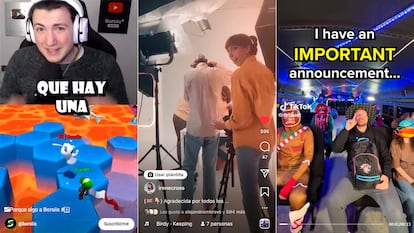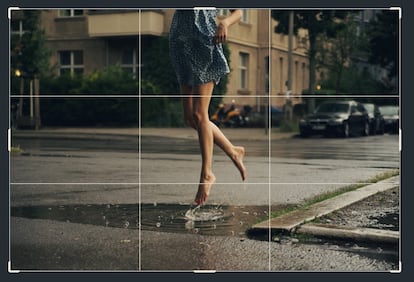‘It used to be dumb, but now it’s everywhere’: welcome to the era of vertical video
In a few short years, what once was one of the most disdained formats has become established as the favored choice for all the main platforms

“This is the first time where content can actually go viral on every single platform,” said MrBeast, the world’s most popular youtuber, in January. “It’s weird, I haven’t heard a single person talk about it.” That incredible form of content is vertical video. Nobody saw it coming, but the meteoric ascent that this format has experienced in recent years has been unstoppable.
Spotify has just announced that its app will also be based on this format. Its founder, Daniel Ek, is aware of its importance: “It is the biggest change to the platform since it became available on phones,” he said during its presentation. In just two years, all the main social networks have created a specific space for vertical video: Instagram, Facebook, Snapchat, YouTube, Twitter, Reddit, and now Spotify too. Apart from their usual screens, they all have a special interface to jump from video to video.
• El video vertical de "LA SANTA" de @lolaindigomusic consigue sumar un total de 2,6 millones de visitas entre las diferentes plataformas!!! pic.twitter.com/Q5CsmRcbJ2
— Lola Indigo Data 📈 (@LolaData) March 17, 2023
And then there is TikTok, of course, the great driving force behind this vertical tsunami. Its explosion during the Covid-19 pandemic is the main responsible for the format’s rise from a controversial, minor genre, to almost dominant on mobile platforms. However, although it is the main cause, it is not the only one.
Raúl Ordóñez, a digital marketing consultant and trainer with 700,000 followers on TikTok, details four possible causes: vertical video is the natural format of mobile phones, cameras have improved a lot, they are very short pieces of content and, obviously, TikTok’s powerful algorithm. “I like to talk about TikTok’s addictive surprise because it broke the dictatorship of traditional algorithms such as Facebook or Twitter, where the same content from the same people with the same opinions tended to appear,” he says. “TikTok, on the other hand, is Disney World.”
This new combination spread quickly across all platforms. “I don’t think it’s an accident,” says Gustav Söderström, co-president of Spotify, referring to how his platform will incorporate the vertical format to discover new songs. “The world didn’t just randomize into these auto-playing cards. It is evolution. It is the most effective way to quickly understand and evaluate lots of content.” Swiping from one full-screen video to another is the most efficient way to discover new and interesting content on a smartphone, more so if we talk about music.
Amazing viralization
The format’s success has brought another juicy novelty for creators: unprecedented levels of viralization. “When you get 35,000 followers [on TikTok] in 24 hours, which is more than I have accumulated on Twitter in 15 years, you notice something strange,” says Ordóñez. It happens on all platforms: “On Instagram, any traditional publication such as a carousel, a photo, a story, reaches approximately 20% of my followers. Meanwhile, the reels [Instagram’s vertical video format] not only reach 95% of my followers, but they multiply the reach to non-followers by about seven or eight,” he explains.
This explosion alone would be extraordinary. But it is even more so if we take into account that until not long ago vertical video was disdained with a contempt that even acquired a name: vertical video syndrome, which on Google yields millions of results, most of them from a decade ago. There is a YouTube video from 2013 that perhaps launched the term: “Say no to vertical videos. Vertical videos happen when you hold the camera the wrong way. Your video will end up looking like crap,” the characters warn. “Vertical video syndrome is dangerous.”
Ordóñez recalls those days of scorn. “At first there were many divergent voices. Years ago, someone recording a video vertically was a sacrilege, they called them dumb [...] and now it’s almost the complete opposite and it is everywhere.” The consequences of that critical past can still be seen today.Gaming youtuber Borsiis believes that vertical videos have not reached their potential yet: “Vertical video is still perceived as junk content, something extra. You make a proper long video, and you take clips for the short content. Or maybe you’re bored at home and make a quick story with a TikTok filter. People have that perception because a lot of creators do that and a lot of viral vertical videos are stupid. Many people use them to go viral quickly with unpolished videos,” he says.
But that is precisely the reason why it still has a long way to go. “As a creator of exclusively vertical videos, I can attest that the work is not appreciated. I’ve gotten 500,000 subscribers. I was able to add 100,000 in 5 days, a very high growth. Still I get the usual comments saying ‘meh, it’s because they’re shorts’ [YouTube’s vertical videos], belittling it,” he says.
For Borsiis, vertical video comes to fill a mostly unexplored space that the new generations will come to expect more: explanatory microcontents. Just as Spotify believes that it is the best format for discovering new songs, Borsiis believes that it is the best format to explain specific topics well: “We have an increasingly impatient society. I myself am the first one to speed up a long video. In a five-minute tutorial, I want to see the three seconds that interest me. Thus, it’s better to make a 30-second video that people will see in its entirety if you make it entertaining, than making five minutes just so three seconds are seen. It is easier to retain [viewers] with a short,” he explains.
Making the most of a fresh format
The briefness and the unrefined feel are two possible benefits of vertical videos. However, the critics are right about something: in a vertical video, you see less. The composition is poorer. Of course, this does not mean that there is no room to play: “I don’t think we have lost the capacity for expression,” says photographer Rodrigo Rivas. “In any case, we have won, because there is one more format. Horizontal video is now consumed in a calmer way, while vertical video, although it can be technically accomplished, as a general rule tends to have a fast consumption, it doesn’t take more than a minute. It is a social change.”
People who work with images have been living with this difficult dilemma for a couple of years now: brands or clients want it all (horizontal for internet or TV and vertical for social media), so when they make videos they have to strike a balance to include shots and resolutions that can be used for both. Some resort to grids that allow them to see what will appear in a possible vertical video; others simply use two cameras.

“Vertical video is a real trend,” says Irene Cruz, director of photography. “I started making vertical videos around 2019.” That first time she made a horizontal video which she then had to cut, a complicated practice that generates controversy in the trade. Since then she has adapted, although the instructions are still not 100% clear: “I leave lots of air everywhere, because I don’t usually edit. I’ve gotten used to recording large,” she says, and adds: “To me, it is a very difficult way of working. I now work with the grid in the camera, to know how to cut it later. It is a useful resource. The client wants everything and you are one person with one brain and very little time,” she adds.
Sign up for our weekly newsletter to get more English-language news coverage from EL PAÍS USA Edition
Tu suscripción se está usando en otro dispositivo
¿Quieres añadir otro usuario a tu suscripción?
Si continúas leyendo en este dispositivo, no se podrá leer en el otro.
FlechaTu suscripción se está usando en otro dispositivo y solo puedes acceder a EL PAÍS desde un dispositivo a la vez.
Si quieres compartir tu cuenta, cambia tu suscripción a la modalidad Premium, así podrás añadir otro usuario. Cada uno accederá con su propia cuenta de email, lo que os permitirá personalizar vuestra experiencia en EL PAÍS.
¿Tienes una suscripción de empresa? Accede aquí para contratar más cuentas.
En el caso de no saber quién está usando tu cuenta, te recomendamos cambiar tu contraseña aquí.
Si decides continuar compartiendo tu cuenta, este mensaje se mostrará en tu dispositivo y en el de la otra persona que está usando tu cuenta de forma indefinida, afectando a tu experiencia de lectura. Puedes consultar aquí los términos y condiciones de la suscripción digital.
More information
Archived In
Últimas noticias
Chris Martin, Taylor Swift, Elijah Wood and other famous wedding ‘crashers’
‘How does it feel to be a failure?’: Elizabeth Berkley’s journey from ‘Showgirls’ ridicule to vindication
The story of the Málaga virus: The code that haunted Google’s cybersecurity center director for 30 years
The impact of Ecuador’s mega-prison: A polluted river, cleared forests and military checkpoints
Most viewed
- Christian Louboutin: ‘Young people don’t want to be like their parents. And if their parents wear sneakers, they’re going to look for something else’
- The low-cost creative revolution: How technology is making art accessible to everyone
- Liset Menéndez de la Prida, neuroscientist: ‘It’s not normal to constantly seek pleasure; it’s important to be bored, to be calm’
- All the effects of gentrification in one corner of Mexico’s Colonia Roma
- December Social Security and SSI payments: Dates, double checks and the 2026 COLA increase











































